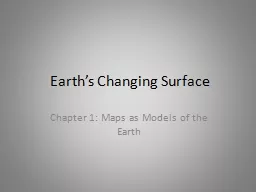

Earths Changing Surface Chapter 1 Maps as Models of the Earth Warmup Welcome back Please pick up your new textbook on the front table Take a moment and write your name on the inside front cover Be ready to tell me your text book number ID: 766453
Download Presentation The PPT/PDF document "Earth’s Changing Surface" is the property of its rightful owner. Permission is granted to download and print the materials on this web site for personal, non-commercial use only, and to display it on your personal computer provided you do not modify the materials and that you retain all copyright notices contained in the materials. By downloading content from our website, you accept the terms of this agreement.
Earth’s Changing Surface Chapter 1: Maps as Models of the Earth
Warm-up: Welcome back! Please pick up your new textbook on the front table. Take a moment and write your name on the inside front cover. Be ready to tell me your text book number. Homework: Read text pages 4-9 and define “Terms to Learn” Maps: Models of the World or Are they?
Follow the Yellow Brick Road Using colored pencils and paper, draw a map showing how to get from this classroom to any of the following places: the gym, the music room or Miss Moonis’s room. Be sure to include enough information for someone unfamiliar with our school to find this way.
Analysis: 1 : Switch with a partner. Try to figure out where the map is leading you. 1: Is your map an accurate picture of your school? Why or why not? 2: How do you think your map could be made better? What are some limitations of your map? 3: Compare your map with your partner’s map. How are thy similar? How are they different? Begin Homework: Read text pages 4-9 and define “Terms to Learn”
Warm-up: Take out last night’s homework. Take a few minutes and review your definitions. Homework: Review vocabulary. Complete the Section Review on page 9 (It will be collected for a grade). Maps: Models of the World or Are they?
Today’s agenda: Pictionary …. Of sorts! Teams One player from each team will draw a word (one from last night’s homework list). Team mates will try to figure out what the pictures represent. If your team mates do not figure out what your drawings mean quick enough, the other team can have a shot at stealing your turn!
Vocabulary Map- model of Earth’s surface. Cardinal directions- N, S, E, & W. Longitude- imaginary lines that run through the poles.Latitude- imaginary lines parallel to the equator.Equator- divides Earth into Northern & Southern Hemispheres.Prime meridian- 0 degrees longitude; runs through Greenwich, England.
Longitude- lines are NOT parallel!
Vocabulary Reference point- fixed point from which direction and location are described. Magnetic north vs. True north- the angle of correction for the difference between geographic north (true north) & magnetic north.
Conclusion Begin completing the Section Review on page 9.
Warm-up: Is there any such thing as a flat sphere? *Take out last night’s Section Review Homework: Read text pages 10-15. Define “Terms to Learn” ( unless done so during class today!) Section 2: Mapping the Earth’s Surface
Agenda Review vocabulary Check and collect last night’s homework Map projectionsYour turn!
3 kinds: Mercator projection : cylinder; lines of latitude and longitude are spaced farther apart making countries look bigger. Conic projection: cone; No distortion along the line of latitude where the globe comes in contact with the cone; BEST for mapping landmasses where the majority of the area is found east and west (Ex. U.S)Azimuthal or Planar projection: plane; distortion increases as you move further away form the N. pole. Used by mapmakers to transfer the image of Earth’s curved surface onto a flat surface. All flat maps have some amount of distortion! Map projections
Let’s Make Our Own! Directions http://www.rmg.co.uk/upload/pdf/globe_instructions1.pdf Final Image
Conclusion: What kind of map projection did we make?
Warm-up: Let’s make our spheres! *Turn in Tuesday night’s Section Review (in the bin) Homework: Complete the Section Review on page 15. Read text pages 16-19. * TEST on Wed., Arpil 17th Section 2: Mapping the Earth’s Surface Using Modern Maps
Agenda Our own map projection Section Review Modern mapmakingTopographic maps
Let’s Make Our Own! Directions http://www.rmg.co.uk/upload/pdf/globe_instructions1.pdf Final Image
Modern Mapmaking At a glance http://www.abc.net.au/btn/story/s3529619.htm
Topographic Maps Topographic maps- a map that shows surface features (natural- rivers, lakes, mountains; manmade- cities, roads, and bridges and elevation), or topography, of the Earth.
Contour lines Relief- differences in elevation of highest and lowest points in an area.
Reading a Topographic Map Means reading symbols
Rules Contour lines never cross. All points along contour line represents a single elevation. The spacing between lines depends on slope. Closely spaced lines represent a steep slope. Widely spaced lines represent a gentle slope. Contour lines cross at a valley or stream are in the shape of a “V”. Closed circles are either hills, mountains or depressions. Depressions have short lines inside the circle.
Let’s see what you have learned!
Warm-up: Take out a new sheet of loose-leaf. Open text books to Chapter 1. Homework: Review vocabulary. TEST on Wednesday. Maps as Models: Chapter Review
OBJ: Use a variety of maps to navigate to specified areas. Warm-up: none Homework: Begin reading text pages 30-35. Define “Terms to Learn”. Maps as Models: Performance Assessment
Today Answer the following questions for each map you are given. You need to use at least 3 different maps.Questions:What is you map a map of?Draw and label at least 3 features on your map’s key.What is the map’s interval (scale)?Choose two points on your map (city to city, town to town, …). Write a series of directions describing how one could get from point A to point B. Make sure your directions are clear and concise.